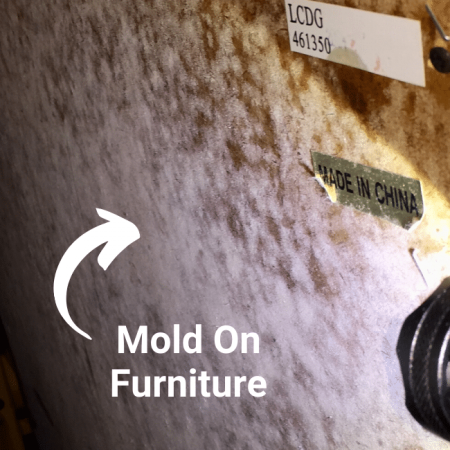What Is Mold Exactly?
This chapter talks about what mold is, why it is necessary outside and how it can affect our health when it actually grows indoors.
Mold is a fungus, and subsequently the world’s best decomposer.
It is needed to break down organic matter such as decaying plant matter, dead trees, fallen fruit, etc. Without it, we would be slopping around in a swampy mess of rotting vegetation. Not Cool!
Mold has been thriving on this earth long before humans have been on the planet, and has no intention of leaving.
Outside, mold is not usually a problem. However, mold grows on anything organic, so it becomes an issue when it invades our homes and especially our personal items.

How Does Mold Affect Us?
Prolonged mold exposure within our homes can cause health issues, especially for people who have mold sensitivities, including infants, those with compromised immune systems and the elderly.
It has been well documented that many people have, and continue to suffer adverse health effects when they are exposed to mold.
Organizations such as the Mayo Clinic and CDC (Centers for Disease Control and Prevention) archive a wealth of knowledge on the subject.
Many suffer “cold or flu” like symptoms, itchy eyes, nose and throat, rashes, sneezing and stuffy nose.
Those with compromised respiratory issues like asthma may experience difficulty breathing, coughing, and shortness of breath or worse when exposed to mold.
FACT
Unfortunately there is no definitive consensus on how mold exposure will affect an individual, or how it affects one person from another.
A person’s reaction to mold depends on the type, or species of mold and how he or she processes that particular type of mold.
Further, a person may be allergic to one type of mold but not another. This holds true for all people.
To this day mold has continued to be the topic of much debate across the nation, resulting in problems for building owners, while spawning a thriving legal subcategory all on it’s own.
However, there is still much to contemplate when it comes to medical claims involving mold.
The common consensus is that people can get sick when they ingest or breathe the harmful mycotoxins (poisons) not only from the infamous “black mold” but a whole host of other mold species as well.
Mold spores are and will continue to be in every home. There is no way to get rid of them completely.
With the right approach, mold can easily be removed from all surfaces, even structural elements as noted from a basement mold inspection.
Mold can catch a ride into our homes through open doors, windows or settle on anything that comes into our homes including us. Mold spores are so tiny that we actually need a high-powered microscope to identify them.

What Does Mold Need To Grow?
Mold requires only moisture, an organic food source (dirt, dust, debris, skin cells, cellulose, etc.) and the right temperature to grow.
FACT
Did you know that mold spores sit dormant for long periods of time until the right conditions (temperature, moisture and nutrients) are available?
Moisture is the most important ingredient, so your home needs to be dry to keep mold under control.
Builders have to be careful, especially in wet regions. Our homes have been built with organic materials that mold loves to consume. Just take a look at this photo with mold on the drywall.
If the structure of a home has not been properly dried out before the vapor barrier and drywall is installed, then mold can, and will grow in a brand new home.

Is Preventing Household Mold The Answer?
As a past home inspector, and full time mold inspector, I investigate properties, while looking for the numerous causes of moisture issues inside and outside of the home.
Some of the more common places where you may not consider (until you go there) would be the attic.
Through practical experience and continuous training on mold, water damage, indoor air quality and mold removal, I offer a unique perspective on the numerous factors that lead to mold infestations within a home.

So yes, in my opinion, preventing and managing mold is just as or more important than dealing with it… which is why I felt compelled to write this mold prevention guide.
One of the main challenges we have with the mold industry is the fact that there is far more attention given to dealing with existing mold issues, rather than trying to prevent them in the first place.
Remediating large-scale mold infestations can cost thousands. Often, these issues can be prevented with the right know-how.
The main problem is that people are typically reactive rather than proactive when it comes to dealing with mold.
Perhaps it stems from the fact that they may not actually know exactly how it was caused, or the situation may be beyond their control – Renters moving into a moldy home, for example.
This is especially the case with bathroom mold. The picture shows mold beside the shower/tub.
The mold has been there for quite some time, which is destructive and unnecessary. Both renters and landlords need to communicate better to prevent this scenario from continuing.
Understanding why and where mold grows in our homes will help us prevent associated problems from mushrooming (yes, mold is a fungus & the pun was intended) out of control.

Unfortunately, we’ll never be able to get rid of household mold completely, which is why it becomes critical to control, manage and prevent it.
That wraps up our first chapter on mold prevention. In the next chapter we look at 9 different types of mold, and which ones you need to be concerned about.
